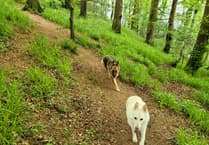We are all aware of climate change and the issues around burning fossil fuels are well documented, so why do the commoners on Dartmoor continue to carry out burns?
Climate change has affected Dartmoor; the prevailing South-westerly winds bring warm air and moisture providing excellent growing conditions for the Dartmoor vegetation.
This is often a mixture of the low growing Western Gorse Ulex gallii with some heather Calluna vulgaris and Bilberry Vaccinuim myrtillus or Whortleberry as we would call it.
More often than not there could also be Molinia caerulea, a dominating unpalatable grass interspersed with the gorse. In some areas the Molinia caerulea is the dominant vegetation, forming hummocks that make it difficult to travellers on foot.
The Molinia dominant habitat cover vast areas of Dartmoor, this type of vegetation is rank and unpalatable to livestock for much of the year, with only a few months in the summer when this rough grass is palatable to livestock.
Whilst this sort of habitat is valued, it requires careful management. A bit like a garden, the plants need tending. If we were to leave the moor and not manage it, all the vegetation would be of the same age and structure.
As with all plants, pruning and control is a benefit to the plant itself. By managing the vegetation and enabling a variety of habitat structure, age and height, different species will colonise the varying habitat.
There are other problems associated with unmanaged vegetation, public access is one. Western Heath can coalesce to such a degree that vast areas become impenetrable and restrict access for both visitors and livestock. This means that existing paths and tracks used by visitors become overused, damaged and eroded exposing bare peat. It also restricts the available vegetation for the livestock to graze, often concentrating them into smaller areas.
Uncontrolled vegetation becomes too dense for many bird species to nest in; with problems arising for the success of the nest at risk from unseen predators.
Grazing the vegetation with livestock is always the best option, but because the livestock numbers have been significantly reduced due to environmental schemes, other methods of vegetation control are required.
Cutting with a tractor mounted swipe or a remote control robo flail are options, but the vegetation grows back very differently to if it was burned. The machines and granite rocks do not mix.
This is where swaling comes in. Commoners work together and work to a plan to burn small areas of vegetation in the defined period October 1 to April 15, with an agreed end date on the Dartmoor commons of March 31.
Swaling is the practice of burning the vegetation to sweeten the pasture for livestock, to ensure the vegetation is varied in structure and age. Swaling can reveal impressive archaeological features that could not be revealed by cutting – take the triple stone row on Spitchwick common revealed in 2012, archaeologists had no idea this was a triple stone row, until the area was swaled. Swaling controls the tick population which cause health issues for both animals and humans.
Heather beetle destroys heather plants, but burning heather at a certain stage limits the damage done by the heather beetle. Following a burn, heather will grow back and germination of the heather seeds in the soil will be triggered by the heat and the smoke from the fire.
Swaling areas of moorland encourages the livestock to graze in different parts of the moor. It is a natural process and helps with controlling the amount of vegetation on the moor that as a wildfire is dangerous as the amount of vegetation is a significant fuel load.
Many environmental agreements restrict the areas swaled to less than 2ha, with a hold on any burning in 2020 and 2021 due to covid, Dartmoor is at greater risk than ever from a serious wildfire. Spring 2022 saw just 1% of the total Dartmoor moorland area swaled that is around a total of 360ha.
Fire breaks are cut across the commons will help control a fire, but unpredictable, sudden wind change can fuel a fire. The best way to stop a wildfire is for it to reach a previously burned site. This will stop a wildfire.
Commoners undertake training to fight wildfires on Dartmoor, this enables them to work alongside the fire service to provide much needed manpower and provide the local knowledge of the area in the event of a wildfire.
Some fires do get out of control, often because of a change in wind direction and despite the best efforts of the commoners and their firefighting equipment – beaters and fogging machines that mist water onto the fire, assistance is needed and the fire service are called.
As the vegetation on the commons of Dartmoor builds, so does the risk of a catastrophic fire that will burn into the peat. None of us want that, so we hope that by managing the vegetation by a combination of controlled burns, grazing and cutting we can avoid the Dartmoor Catastrophe.





Comments
This article has no comments yet. Be the first to leave a comment.